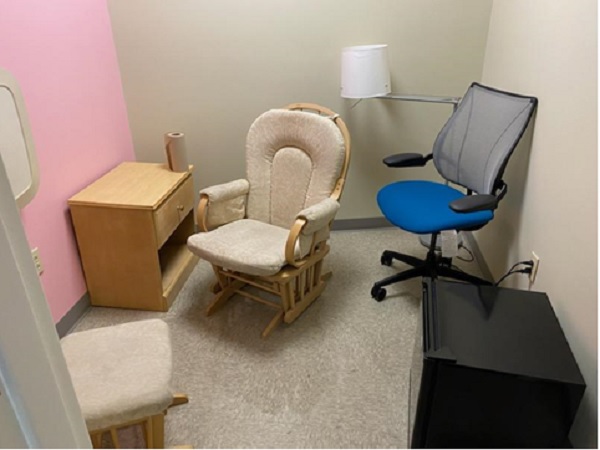Lactation policy helps support parents in the VCU community

New policy and lactation room reviews are latest additions to resources Equity and Access Services offers to support pregnancy and parenthood
The work of one student can have a profound impact on a campus. While the development and implementation of the new campus-wide lactation policy has involved dozens of people, it started with Kirsten Olsen, a former master’s degree student in VCU’s School of Education.
“Kirsten approached Karah Gunther, VCU’s vice president of external affairs and health policy, with information on the lactation policy that VCU Health had implemented,” explains Cleopatra Magwaro, the associate vice president of institutional equity within the Office of Institutional Equity, Effectiveness and Success. “My office took it on as an accessibility and equity project.”

Magwaro created a working group of 28 people that included VCU and VCU Health System medical doctors, nurses, social workers, students and other faculty and staff, several who had assisted in similar projects on a national level. While one committee within the group worked on drafting a lactation policy, other committees were in charge of reviewing the physical lactation spaces on campus and communicating the details of the policy to the campus community.
Unanimously passed last month, the new policy provides guidelines that support both employees and students who need lactation space while on campus. It requires that spaces other than restrooms be designated or designed to allow lactating individuals to express milk in a private, comfortable setting. The policy is featured on a new page on the Equity and Access Services (EAS) website that includes a comprehensive list of resources in support of Pregnancy, Parenthood and Lactation.
Magwaro says the need for accessible lactation spaces quickly came to the forefront. “We heard directly from students about how they use current lactation spaces and one of them detailed how she’s carrying two sets of bags every day: one with lactation equipment and one with what she needs for her studies,” she explains.
“In the building where most of her classes are, student life mostly happens on the 6th and 7th floors but the lactation spaces are in the basement,” Magwaro says. “It doesn’t really feel like belonging in the way that we espouse it here at VCU.”
We don’t know of any other school in the country that is specifically designing lactation spaces in all new buildings.
Cleo Magwaro, associate vice president of institutional equity
The work of the committee has led to VCU taking the lead in supporting lactating individuals on campus. “We worked with two architects and a designer so when VCU is constructing new buildings moving forward, lactation spaces will be already strategically accounted for in the design and they are not going to be in the basement,” says Magwaro. “We don’t know of any other school in the country that is specifically designing lactation spaces in all new buildings.”
Dana Lippman, VCU’s ADA specialist with EAS, has been reviewing currently designated lactation spaces on campus for accessibility and adherence to the new policy. “I’d say the quality of current spaces is something of a mix,” Lippman says. “Some are great but many are in basements or shunted off to the side. Sometimes, even if there is a great space, not many people know it’s there or there are complications like access codes to get into them.”
“We are also working to add lactation spaces in places like the Student Commons, high traffic areas where there is a need,” she says.

With the approval of the lactation policy, Magwaro is working on next steps like improving access to current spaces and increasing communication about what is available. “Part of our low-hanging fruit philosophy is making those spaces that are currently available more accessible and working with building managers to identify appropriate spaces for new lactation spaces,” she says.
Lippman says there are some relatively simple standards for what needs to be in a lactation space that she works on addressing. “There are best practices around what should be provided: is there a sink or way to wash your hands? Is there a trash can? I saw many spaces that didn’t have trash cans.” she explains. “I’m working with building managers on figuring out the common things and then setting a standard that goes above that.”
Magwaro says that accessible lactation spaces are part of creating an inclusive environment. “It’s a human nutrition issue,” she says. “We talk about having five generations in the workplace. People need to be able to bring their whole selves to school or to their workplace, even when they’re lactating.”
“Kirsten planted a seed and now a tree is growing from her efforts,” says Magwaro.
Categories EAS, Inclusion